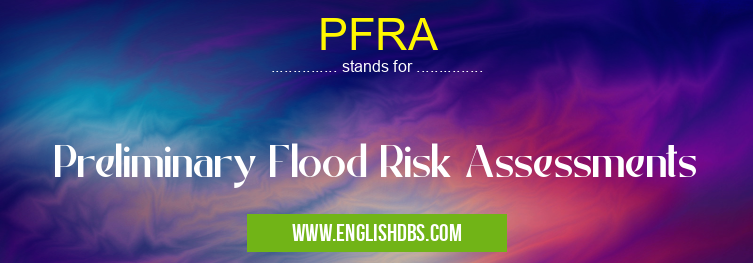What does PFRA mean in UNCLASSIFIED
PFRA stands for Preliminary Flood Risk Assessments. It is a crucial tool used to assess and manage flood risks, particularly in areas vulnerable to flooding. PFRA provides valuable information to help decision-makers, communities, and individuals understand and mitigate potential flood hazards.

PFRA meaning in Unclassified in Miscellaneous
PFRA mostly used in an acronym Unclassified in Category Miscellaneous that means Preliminary Flood Risk Assessments
Shorthand: PFRA,
Full Form: Preliminary Flood Risk Assessments
For more information of "Preliminary Flood Risk Assessments", see the section below.
Key Points
- PFRA involves detailed studies and analyses of historical flood data, hydrological modeling, and land use patterns to identify areas at risk of flooding.
- It evaluates potential flood depths, velocities, and extents, enabling the development of flood hazard maps and risk assessments.
- PFRA supports informed decision-making regarding land use planning, development regulations, and emergency response measures to reduce flood risks.
- By understanding flood risks, communities can implement protective measures such as floodwalls, levees, and evacuation plans to safeguard lives and property.
- PFRA contributes to sustainable development and resilience by promoting flood-resilient practices and mitigating the impacts of flooding.
Essential Questions and Answers on Preliminary Flood Risk Assessments in "MISCELLANEOUS»UNFILED"
What are Preliminary Flood Risk Assessments (PFRAs)?
PFRAs are comprehensive assessments that evaluate the potential flood risk in a given area. They identify areas that may be at risk of flooding, estimate the likelihood and severity of flooding, and provide recommendations for mitigating flood risks.
Why are PFRAs important?
PFRAs play a crucial role in flood risk management by providing valuable information that can help communities prepare for and mitigate flood hazards. They help identify vulnerable areas, prioritize flood protection measures, and inform land use planning decisions to reduce the risk to life and property.
How are PFRAs conducted?
PFRAs typically involve multiple steps, including data collection and analysis, hydraulic modeling, risk assessment, and stakeholder engagement. They consider factors such as historical flood data, rainfall patterns, land use, and topography to determine flood risks.
Who uses PFRAs?
PFRAs are used by a wide range of stakeholders, including government agencies, flood management authorities, insurance companies, landowners, and the general public. They provide valuable information for decision-making related to flood risk reduction, land use planning, and emergency preparedness.
How can I access PFRAs for my area?
The availability of PFRAs varies depending on the location. Check with local government agencies, flood management authorities, or relevant websites to find PFRAs for your area.
Final Words: PFRA is an essential tool for proactive flood risk management. It provides vital information to help communities prepare for and reduce the consequences of flooding, ensuring the safety, well-being, and economic prosperity of those living in flood-prone areas. By embracing PFRA, decision-makers can create more resilient communities and minimize the devastating impacts of flooding.
